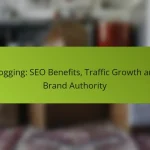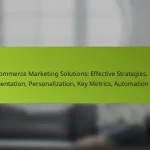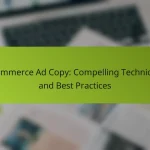What are the best pay-per-click advertising solutions for e-commerce?
The best pay-per-click (PPC) advertising solutions for e-commerce include platforms that effectively reach target audiences and drive sales. Key options are Google Ads, Bing Ads, Amazon Advertising, and Facebook Ads, each offering unique benefits tailored to different marketing strategies.
Google Ads for E-commerce
Google Ads is a leading PPC platform that allows e-commerce businesses to display ads on Google’s search results and across its display network. Advertisers can target specific keywords relevant to their products, ensuring visibility when potential customers search for related terms.
To maximize effectiveness, focus on creating compelling ad copy and using high-quality images. Utilize ad extensions to provide additional information, such as pricing and promotions, which can improve click-through rates. Regularly monitor and adjust bids based on performance metrics to optimize your budget.
Bing Ads for Retailers
Bing Ads, now known as Microsoft Advertising, offers a cost-effective alternative to Google Ads, particularly for reaching users on the Bing search engine. It often has lower competition, which can lead to reduced costs per click and better ad placements.
Retailers should consider using Bing Ads to target specific demographics and geographic locations. The platform allows for easy integration with Google Ads campaigns, enabling advertisers to import existing campaigns and adjust them for the Bing audience. Regularly analyze performance data to refine targeting and ad content.
Amazon Advertising for Product Visibility
Amazon Advertising is crucial for e-commerce businesses selling on Amazon, as it enhances product visibility directly on the platform. This includes Sponsored Products, Sponsored Brands, and Display Ads, which help drive traffic to product listings.
To succeed with Amazon Advertising, focus on optimizing product listings with relevant keywords and high-quality images. Monitor your campaigns closely, adjusting bids based on sales performance and return on ad spend (ROAS). Utilize Amazon’s reporting tools to gain insights into customer behavior and refine your advertising strategy.
Facebook Ads for Targeted Campaigns
Facebook Ads provide a powerful way to reach specific audiences through targeted campaigns based on user demographics, interests, and behaviors. This platform is particularly effective for e-commerce businesses looking to engage customers visually with eye-catching ads.
When creating Facebook Ads, use high-quality visuals and compelling calls to action. Experiment with different ad formats, such as carousel ads or video ads, to see what resonates best with your audience. Regularly test and optimize your campaigns based on engagement metrics to improve performance and reduce costs.
How to optimize pay-per-click campaigns for e-commerce?
To optimize pay-per-click (PPC) campaigns for e-commerce, focus on targeting the right keywords, crafting compelling ad copy, and ensuring landing pages convert visitors. Each element plays a crucial role in maximizing return on investment and driving sales.
Keyword Research Techniques
Effective keyword research is essential for successful PPC campaigns. Start by identifying keywords that potential customers use when searching for products similar to yours. Utilize tools like Google Keyword Planner or SEMrush to discover high-volume, low-competition keywords.
Consider long-tail keywords, which are more specific and often lead to higher conversion rates. For example, instead of targeting “shoes,” aim for “women’s running shoes size 8.” This specificity helps attract more qualified traffic.
Ad Copy Best Practices
Your ad copy should be clear, engaging, and relevant to the keywords you are targeting. Highlight unique selling points, such as discounts or free shipping, to entice clicks. Use strong calls to action like “Shop Now” or “Limited Time Offer” to create urgency.
Test different versions of your ad copy to see which performs best. A/B testing can reveal what resonates with your audience, allowing you to refine your messaging for better results.
Landing Page Optimization Strategies
Once users click on your ad, the landing page must deliver a seamless experience. Ensure that the landing page aligns with the ad’s promise, featuring the same keywords and messaging. This consistency builds trust and encourages conversions.
Optimize your landing page for speed and mobile responsiveness, as slow-loading pages can lead to high bounce rates. Aim for a loading time of under three seconds and ensure the design is user-friendly across devices.
What are the costs associated with e-commerce PPC advertising?
The costs associated with e-commerce PPC advertising primarily include the amount spent on each click, which can vary significantly based on competition, industry, and targeting options. Advertisers need to consider not only the cost-per-click (CPC) but also budget allocation, seasonal fluctuations, and expected return on investment (ROI).
Average CPC Rates for E-commerce
Average CPC rates for e-commerce can range from a few cents to several dollars, depending on the product category and competition level. For example, highly competitive sectors like electronics may see CPCs in the low to mid dollars, while niche markets might experience lower rates.
It’s essential to regularly monitor and adjust bids based on performance metrics. Tools like Google Ads provide insights into average CPCs for specific keywords, helping businesses make informed decisions about their advertising strategies.
Budgeting for Seasonal Campaigns
When budgeting for seasonal campaigns, businesses should anticipate increased competition and adjust their PPC budgets accordingly. For instance, during holiday seasons, CPCs may rise due to higher demand, necessitating a larger budget to maintain visibility.
Setting aside a specific percentage of your overall marketing budget for seasonal spikes can help manage costs effectively. Consider analyzing past performance data to determine the best times to increase spending and maximize returns.
ROI Expectations for PPC Ads
ROI expectations for PPC ads can vary widely, but a common benchmark is aiming for a return of at least two to three times the ad spend. This means that for every dollar spent on PPC, businesses should ideally generate two to three dollars in revenue.
To improve ROI, focus on optimizing ad copy, targeting the right audience, and refining landing pages. Regularly reviewing campaign performance and making data-driven adjustments can significantly enhance overall effectiveness and profitability.
What metrics should e-commerce businesses track in PPC campaigns?
E-commerce businesses should focus on key metrics such as Click-Through Rate (CTR), Conversion Rate, and Cost Per Acquisition (CPA) to evaluate the effectiveness of their PPC campaigns. Tracking these metrics helps identify areas for improvement and optimize advertising spend for better returns.
Click-Through Rate (CTR)
Click-Through Rate (CTR) measures the percentage of users who click on an ad after seeing it. A higher CTR indicates that the ad is relevant and engaging to the target audience. Generally, a good CTR for e-commerce PPC campaigns ranges from 2% to 5%, but this can vary by industry.
To improve CTR, consider refining ad copy and targeting specific demographics. A/B testing different headlines and images can also help identify which combinations resonate best with potential customers.
Conversion Rate Analysis
Conversion Rate refers to the percentage of visitors who complete a desired action, such as making a purchase. For e-commerce, a typical conversion rate can range from 1% to 3%, depending on the industry and product type. Tracking this metric helps businesses understand how effectively their ads drive sales.
Improving conversion rates may involve optimizing landing pages, ensuring a smooth checkout process, and offering promotions or discounts. Regularly analyzing user behavior can provide insights into potential barriers to conversion.
Cost Per Acquisition (CPA)
Cost Per Acquisition (CPA) is the amount spent on advertising to acquire a new customer. This metric is crucial for determining the profitability of PPC campaigns. A sustainable CPA should ideally be lower than the average profit margin per sale, allowing for a healthy return on investment.
To manage CPA effectively, set clear budgets and monitor spending closely. Adjusting bids based on performance and focusing on high-converting keywords can help lower CPA. Regularly reviewing and optimizing campaigns ensures that advertising costs remain in line with business goals.
How does e-commerce PPC advertising compare to other marketing channels?
E-commerce PPC advertising is often more immediate and measurable compared to other marketing channels. While SEO can take time to build traction, PPC allows businesses to drive traffic quickly by paying for ad placements, making it a powerful tool for generating sales in a short period.
SEO vs. PPC for Online Stores
SEO focuses on optimizing website content to rank higher in organic search results, which can lead to sustainable traffic over time. In contrast, PPC provides instant visibility on search engines and social media platforms, allowing for immediate customer engagement. However, while SEO can be cost-effective long-term, PPC requires ongoing investment to maintain visibility.
For online stores, a balanced approach often works best. Using SEO to build a strong foundation while leveraging PPC for targeted campaigns can maximize reach and conversions. Consider allocating around 20-30% of your marketing budget to PPC for optimal results.
Email Marketing vs. PPC Effectiveness
Email marketing is a cost-effective way to nurture existing customers and drive repeat sales, while PPC is effective for acquiring new customers quickly. PPC ads can target specific demographics and interests, making them ideal for reaching potential buyers who may not yet be on your email list.
When comparing effectiveness, consider your goals. If your aim is to boost immediate sales, PPC may outperform email marketing. However, for building customer loyalty and engagement, email marketing remains a strong contender. A combination of both strategies can enhance overall marketing performance, ensuring both new customer acquisition and retention are addressed.








